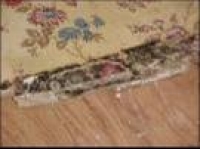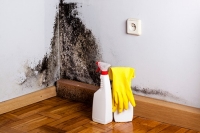Mold

Molds can be found most anywhere – indoors and out. There are thousands of types of mold in Tennessee and all over the world, many of which produce spores. Spores spread easily through the air and can form new mold growth on surfaces when conditions are right. Above all else, molds need moisture to live and grow. If there is mold growing in your home, there must be a source of moisture or a water problem.
Common molds found indoors include Cladosporium, Penicillium, Alternaria, Aspergillusand Trichoderma. Large mold infestations can usually be seen or smelled (musty) as shown in the images above.
What are the health effects of mold?
Mold is usually not a problem indoors unless it finds a damp environment and starts to multiply. Molds can produce allergens, irritants, and in some cases, mycotoxins.
Many people have no reaction to mold. Allergic reactions and irritation are the most common health effects for people sensitive to mold. Mold exposure can also trigger asthma attacks in people with asthma.
According to the Centers for Disease Control and Prevention (CDC), a link between mold and other health effects such as memory loss, lethargy and acute idiopathic pulmonary hemorrhage among infants has not been proven.
The term “Toxic Mold” is often used by the media, but it is not accurate. While some molds do produce toxins, the molds themselves are not toxic or poisonous. Hazards presented by molds that produce mycotoxins are the same as other common molds that may grow in your home.

Should I test my home for mold?
In general, it is not necessary to test for mold. Both the CDC and the Environmental Protection Agency (EPA) do NOT recommend testing. No matter what type of mold is present, you should clean it up and make efforts to prevent further mold growth. Since the effect of mold on people can vary greatly, the presence of mold in the home does not imply a health risk.
How do I prevent mold from growing?
The key to mold prevention is moisture control. Mold will not grow if moisture is not present.
Tips for mold prevention:
- Fix leaky pipes, roofs and windows
- Maintain low indoor humidity, ideally 30-50%.
- Perform regular HVAC inspections and maintenance
- Do not carpet bathrooms and basements
- Ventilate shower, laundry and cooking areas
- Promptly clean up and dry out your home after flooding
How do I clean up mold?
When cleaning up more mold than you might find in a corner of a bathtub or on a piece of old bread- Wear Personal Protection: Gloves, Mask and Goggles. Avoid touching mold or moldy items with bare hands – you may want to wear gloves. Long gloves that extend to the middle of the forearm are recommended. Avoid breathing in mold and getting mold in your eyes – you may want to wear a mask and goggles.
Clean-Up Methods
Within 48 hours, dry non-moldy wet materials to prevent mold growth. Clean moldy materials. Mold can be removed from hard surfaces by wiping or scrubbing with water and detergent. Dry the surfaces quickly. If you choose to use bleach to clean up mold, mix 1 cup of bleach with 1 gallon of water. Never mix bleach with ammonia. Open windows and doors and turn on the vent in the bathroom to increase ventilation.
- Discard moldy porous items that cannot be cleaned, such as carpets and upholstery.
- Do not paint or caulk moldy surfaces. The mold must be physically removed, not just covered up.
Mold in Schools and at Work
If you think your children are sick because of exposure to mold at school or you are sick because of exposure to mold at work, first consult your health care provider to determine the appropriate medical action to take. Secondly, you should notify your building maintenance personnel so the mold can be cleaned up and the moisture issue can be addressed.
The U.S. EPA offers a program to schools called the Indoor Air Quality Tools for Schools (IAQ TfS) Kit. It shows schools how to carry out a plan of action to improve indoor air problems at little or no cost using straightforward activities and in-house staff. For information about Indoor Air Quality Tools for Schools, visit: www.epa.gov/iaq/schools.
Additional Resources
Tennessee Department of Health
Healthy Homes
www.tn.gov/health/cedep/environmental/healthy-homes/hh/mold.html
U.S. Environmental Protection Agency (EPA)
A Brief Guide to Mold, Moisture, and Your Home
www.epa.gov/mold/brief-guide-mold-moisture-and-your-home#tab-1
Mold Remediation in Schools and Commercial Buildings
www.epa.gov/mold/mold-remediation-schools-and-commercial-buildings-guide
National Center for Environmental Health (NCEH)
Mold
www.cdc.gov/mold
